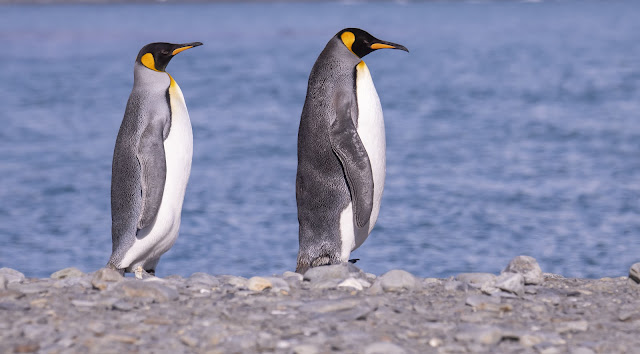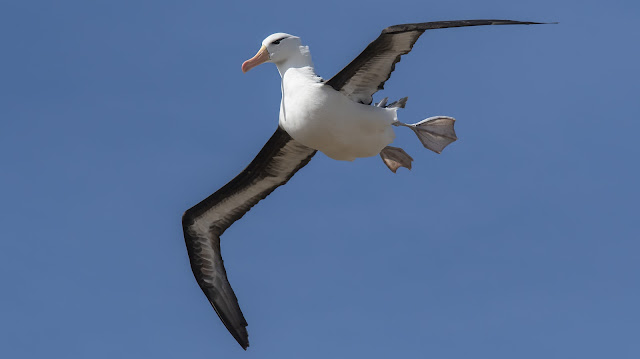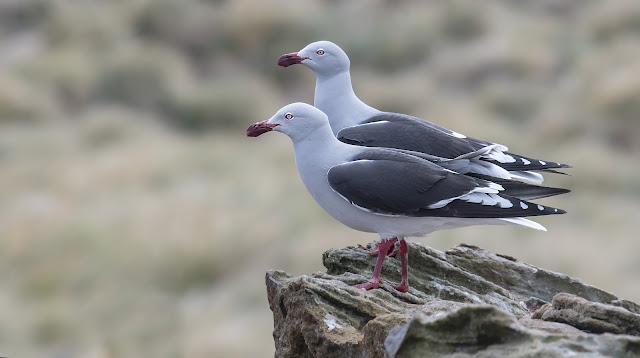At last we reached the Falkland Islands, and on the first day here we had two excellent landings on New Island, at Coffin's Harbour and North Harbour.
Both landings involved a bit of walking, but after 2-3 days at sea, this was actually very welcome. We also had plenty of time at both landings, and as it happened, this was the case at all landings during the whole trip.
The main stars at both landings at New Island were the fabulous Southern Rockhopper Penguins and the Falklands variety of Imperial Shag. The shags actually turned out to be my personal favourites, with their fabulous blue eyes. We also had some stunning flying Black-browed Albatrosses. The albatrosses will be the subject of the next post, as there were so many other spectacular sightings here.
The Imperial Shag were in the middle of nest building, and setting up territories. They looked absolutely stunning as they sat on rocks as they perched on them looking out to sea amongst all the Rockhopper Penguins.
Close-up on the Imperial Shag.
Imperial Shag carrying nesting material. Even showing the blue eye through the material.
Imperial Shag surveying the area.
The Southern Rockhopper Penguins were also preparing to nest, and setting up territory. What was very obvious straight away, was how amazing it was that these flightless birds had managed to get right to the top of the sea cliffs, it really was unbelievable how they manage to do this. It would be difficult for a mountaineer to climb these cliffs, with ropes etc, but these amazing penguins do it by hopping up!! They also have to do it after each fishing trip, to feed their chicks, once they hatch.
Southern Rockhopper Penguin.
Southern Rockhopper looking like a super cool dude.
The Gentoo Penguins were slightly ahead of the Rockhopper in their breeding, as a few of the penguins actually already had eggs. The Gentoo was the most widely spread penguin on our trip, and we saw them in many locations.
Gentoo Penguin with a muddy bill used for his nesting.
Gentoo Penguin with egg.
Gentoo Penguins returned from a fishing trip.
The Magellanic Penguins had been seen on the way to the Falklands in the middle of the ocean. Here it was lovely catching up with them on the beach. Unlike the Rockhoppers, both the Gentoo and Magellanic Penguins had an easier walk to their nesting areas. The Magellanic nesting in burrows well away from the sea, and the Gentoo also on the higher ground, but above ground.
Magellanic Penguin.
Magellanic Penguins about to go fishing.
Upland Geese were seen in good numbers in the areas on both our landings on New Island. The yellow behind the goose is Gorse, that early settlers introduced from Britain. It has certainly taken hold extremely well and is now having to be cleared in some areas.
Upland Goose.
A less frequently seen goose was the Ruddy-headed Goose. However, it was the first goose we saw when we landed on the beach in the zodiacs.
Ruddy-headed Goose.
We had already seen Dolphin Gulls before we had left Argentina, but not in a particularly good position for photography. But here we had several nicely posed individuals, and when two stood together it was a fabulous opportunity.
Dolphin Gulls.
Striated Caracara's were extremely approachable, and were totally unbothered by human presence. There were also good numbers of them around the penguin colonies. Obviously they were hoping for a very easy lunch.
Striated Caracara
Striated Caracara close-up.






























































